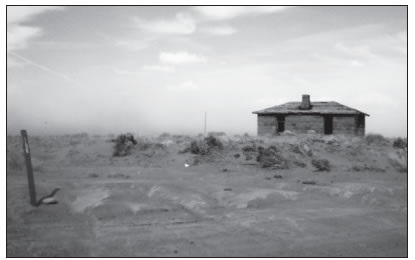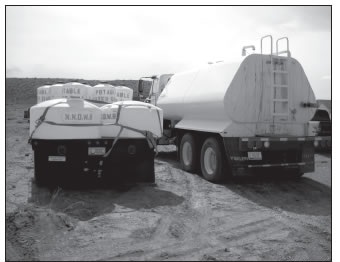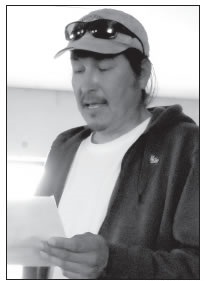Box Springs, Ariz., is cut off by the Little Colorado River from access to any paved roads or the conveniences of groceries, gas stations, banks, electricity and power, not to mention jobs and economic development.
But the community’s willingness to solve its own problems is gaining it recognition as one of the most pro-active areas on the Navajo Nation.

The road to Box Springs, Ariz., is lonely, washboarded and slow, but it’s the route citizens have to use to haul drinking water. Photo by Sonja Horoshko
Surrounding the tiny hamlet is the country in the Navajo Nation Western Agency referred to by some as “Cancer Alley” – the heart ofleetsoii, the uranium belt stretching through the Navajo Nation to the Four Corners region.
It is a place where unregulated water sources are poisoned with contaminants left behind by the un-remediated abandoned mining operations begun in the mid-1940s to fuel the Atomic Energy Commission and the Cold War.
As if the lack of safe, potable water isn’t problem enough, Box Springs, a community of less than 150, is 30 miles from Leupp, Ariz., the nearest town — a drive that often takes an hour. Harsh winter weather and the crenellated, pitched washboard of the partially graveled road add stress to the difficult, typically wind-whipped trip to haul drinking water twice a week for consumption and hygiene. The necessity is the dominant concern for all families living there.
On a mid-April Friday morning, the Tahonnie family opened their home to another community meeting of their grassroots organization, The Forgotten Navajo People, to hear from the Navajo Department of Water Resources about plans for a water delivery schedule beginning that day and to welcome the first 4,000-gallon water truck to the area.
“It is a blessing today, “said Rolanda Tahonnie. “A lot of progress has been made here, so it’s a beautiful day. Two years our water barrel has been completely empty and now it’s full.”
Thirty percent of Navajo families living on the reservation haul drinking water, compared to 1 percent of the U.S. population nationwide. With gas prices exceeding $3.80 per gallon and the expense of wear and tear on the vehicle, the price tag for Navajo consumers is more than 10 times the cost of water for a typical household in Phoenix, one of many Arizona metropolises fed by the water found beneath the reservation and transported through it to cities lying south of the reservation boundaries in Arizona.

New water trucks, purchased with a U.S. Environmental Protection Agency grant, will provide clean drinking water for Box Springs, Ariz., on the Navajo reservation. Photo by Sonja Horoshko
The new water truck was bought with a U.S. Environmental Protection Agency grant awarded to Indian Health Services, providing the Navajo Department of Water Resources funding for a three-year Safe Drinking Water Hauling Feasibility Study and Pilot Project.
Its huge shiny white hulk rumbled over the hill into the clearing that served as a casual parking area filled with pick-ups and trailers loaded with empty water containers. Following close behind was another truck hauling a new trailer and two 200-gallon tanks to be used by the residents there to move their personal water from the Tahonnie watering point and storage tank to homes further out in the community. Tó … Tó … Tó … (drip, drip, drip)
“Today is a great day,” said Forgotten People program director Marsha Monestersky. “Box Springs and the Forgotten People have become the heart of the Navajo reservation. It is the beginning.”
The program is a model that can work in all communities tucked into remote locations where water is scarce and roads are rough. “We are working with Department of Water Resources to schedule regular delivery points here in the Western Agency chapters, including Canyon Diablo, Gray Mountain and Cameron and then Coal Mine,” Monestersky said.
“It is a model water-hauling project,” added the director of DWR, Najam Tajiq. But it was a tough crowd gathered in the room: the local people, the real experts at hauling water. They directed their concerns to him about the lasting reliability of the program.
Benson Willie told Tajiq that they will need to strengthen the one bridge crossing a small arroyo on the road. It was not built to withstand repeated trips carrying the weight of a 4,000-gallon water truck and, he said, “The spigot on the Tolani Lake storage tank has been broken for months. We aren’t allowed to fix it, even though it’s a job any high-school student could do. We’ve been told it’s under warranty and it’s NTUA’s responsibility.” NTUA is the Navajo Tribal Utility Authority.
Adding to the challenge is the anticipated heavy maintenance and repair of the truck because of the ongoing Navajo Department of Roads maintenance issues.
In their mission statement, the Forgotten Navajo People write that they are dedicated to the rebuilding of the communities using a participatory methodology that strives to empower the local communities and ensures that they own and control their sustainable development agendas.
At the meeting, Don Yellowman, president of the group, explained progress at the two additional test-well projects upstream on the Little Colorado at Black Falls Crossing and near Leupp. If the water found there is potable and palatable, it will be piped through 12.4 miles of new waterline extensions to 155 homes in the area of concern.
Someday the water will be here, he told the group. “Nine homes now have bathroom additions and fixtures plumbed and ready for the water when it comes, and they were built by sharing each other’s labors, organizing the people’s teamwork in a traditional Diné way with Black Falls Project Manager Ronald Tahonnie.”
Blue gold
By 2007, the United Nations had announced two human-rights-to-water declarations. The first, issued in 2002, said, “The human right to water entitles everyone to sufficient, affordable, physically accessible, safe and acceptable water for personal and domestic uses.” It requires governments to adopt national strategies and plans of action which will allow them to “move expeditiously and effectively towards the full realization of the right to water.”
But in 2007 the office of the U.N. High Commissioner for Human Rights expanded the statement to include in the definition, “the right to equal and non-discriminatory access to a sufficient amount of safe drinking water for personal and domestic uses. . .” ensuring a sufficient amount of water that is “good quality, is affordable for all and can be collected within a reasonable distance from a person’s home.”

Don Yellowman, president of the grassroots Forgotten Navajo People, speaks at an April meeting in Box Springs, Ariz., about hauling clean water for the community. Photo by Sonja Horoshko
The description fit the needs of Navajo people throughout the reservation. FNP began to work on a submission to the U.N. that would eventually lead to a 2010 historic declaration and help from its own central government in Window Rock, and a Navajo Commission on Emergency Management “Declaration of Public Health State of Emergency” for Black Falls/Box Springs/ Grand Falls.
Contamination in the water sources is attributable to uranium-mining and other natural-resources mining practices that began in the mid-1940s. Monestersky said, “The people here have been drinking contaminated water from unregulated livestock sources and springs for more than 40 years. This was our opportunity to address the issue on a global scale, to declare a human rights emergency.” The case they submitted contained comments from interviews of Diné people denied access to water due to uranium contamination throughout the Navajo Nation, including their neighborhoods in Grey Mountain, Tuba City, Moenkopi and the New Lands.
Currently, the Diné are threatened by new uranium mining just outside their borders, despite a ban on such mining within the Navajo Nation, issued in 2005 by former president Joe Shirley, Jr. Adverse health effects continue, according to the stories in the document prepared by the Forgotten Navajo People, as a result of more than 1,100 un-reclaimed uranium sites throughout the Navajo Nation. The document includes graphic testament to conditions inflicted on the people living around Peabody Coal Company mining operations who are denied access to safe drinking water due to destruction, degradation and diminution of their water sources.
The report also includes a statement alleging that, “The Diné live on lands the U.S. Department of Energy calls a ‘National Sacrifice Area’.”
Response to the submission strengthened relationships with partners already working on the cataclysmic environmental and health disaster. The U.S. EPA Superfund, Indian Health Service, Bureau of Indian Affairs, Department of Energy, Navajo Nation EPA, Navajo Abandoned Mines, DWR, and others, working on remediation and attribution of responsibility, have activated programs addressing the issues since the mid-1990s.
In 2006, Judy Pasternack, journalist and author of “Yellow Dirt,” began publishing excerpts from her work-in-progress in the Los Angeles Times.
The series painted a stark picture of national disgrace and neglect and the continuing presence of radioactive contamination in the Navajos’ “drinking supplies, in their walls and floors, playgrounds, bread ovens, in their churches, and even in their garbage dumps. And they are still dying.”
Hope fueled the work of the grassroots organizations. The Forgotten Navajo People began to feel remembered. They knew best what was needed in their own community and assumed the role of experts working toward solutions.
Ticking meters
But while the picture may have improved for Box Springs, at least in regard to drinking water, the dark legacy of uranium mining hangs over the Navajo Nation like a specter.
A month after the water-hauling meeting, the U.S. EPA announced a Superfund meeting in Tuba City on the Abandoned Uranium Mines project in the Western Agency. Nearly 200 people representing all the communities in the Western Agency crowded the conference room on May 14 with members of several Navajo grassroots environmental-justice and natural-resources organizations, including the Forgotten Navajo People.
Svetlana Zenkin, site assessment manager with EPA Region 9’s Superfund Division, explained the mine screening that provided for the initial evaluation of 520 sites found by 2000. During the first four years of a five-year plan of action, 383 of the sites throughout the reservation have been screened in an initial evaluation.
Sites under investigation in the Western Agency chapters include mines, transfer stations, homes and outbuilding structures, hogans, schools, water sources, tailing piles, landfills, barrow ditches, access roads and the Rare Metals mill site east of Tuba City. All 126 were identified in the original study found in the Abandoned Mines 2000 Atlas. The initial investigation of these was to be completed by the end of May, yielding a prioritized list identifying sites requiring additional investigation.
“Our main goal was to gauge the level of interest in the region, educate the people about our progress and to locate what sites people come into contact with that we didn’t know about,” said Zenkin.
The biggest surprise of the meeting was the contamination level discovered for a site east of the Cameron Chapter House on the west side of the Little Colorado River, not far from Box Springs.
According to Alex Grubbs, a representative of Weston Solutions, the Superfund contract environmental consultants for the project, “The meter maxed out three times … at a million,” which is an actual reading of 1,000 radiation counts per minute— a relative measure of radiation to the surrounding background area. Background radiation is typically between 5 and 60 cpm, rarely exceeding 100 cpm.
Although people in the community believe the site may have been a transfer station for ore, Zenkins said, “We hesitate to label the site until we have finished the intensive study required of such a screen. It has definitely moved to the top of the priority list.”
“Superfund” is a retroactive liability law, not a monetary fund. It has the authority to identify and locate hazardous sites and require the responsible party to fund the clean-up — even if it is a government entity such as the Department of Energy or the Nuclear Regulatory Commission (former Atomic Energy Commission).
Contaminated water is the highest-priority threat because it is the most direct internal contaminant. Today, the subject of safe, clean water is also a hotly contested issue in the Northeastern Arizona Indian Water Rights Settlement.
In a special session in November 2010, the 21st Navajo Nation Council voted 51-24 to pass legislation supporting the settlement.
Ron Millford, a concerned Navajo citizen and opponent of the settlement, asked Superfund project manager Debbie Schechter for a clarification of authority. “Does the EPA Superfund have authority over waivers contained in the settlement?” According to Millford, “The waiver releases all claims against the state or corporations — including Arizona Power Service and Peabody Coal, that may pollute the environment,” including violations of the Clean Water Act.
Because the Superfund can go after any responsible party, it seems logical that it would have authority over such a waiver.
Schechter told Millford, “It is a question that we will ask the EPA lawyers, and get an answer for you on this.” At the time of this writing, Millford had not heard a response from the lawyers.
Green dust
Afternoon breakout groups at the May 14 meeting gave citizens an opportunity to tell their stories directly to the Superfund project managers. Of great concern was potential future contamination from possible Grand Canyon uranium-mining.
A single-parenting father of two young boys said, “I teach my sons to clean up after themselves, to be responsible. What will they think when they learn about the mining residue left behind by the corporations at these natural-resources operations?”
He added that the dust is everywhere and he’s concerned for his children who may play in contaminated soil picked up and blowing in the wind. Another young man called its presence in the windstorms, “unavoidable green dust,” and another woman added that children continue risk exposure when they put it in their mouths. “It tastes like rock candy,” she said.
Sarana Riggs, a young woman living in Tuba City, said she is very concerned about “the potential 50 trucks a day transporting uranium ore from the Grand Canyon through Cameron and Tuba City, Monument Valley and the Utah strip of Navajo Nation to the mill in Blanding, Utah.”
“What is the level of our awareness?” she asked. “What education can we be doing for our communities to prevent a repeat of this contamination and its aftereffects?”
Those answers remain unclear.








